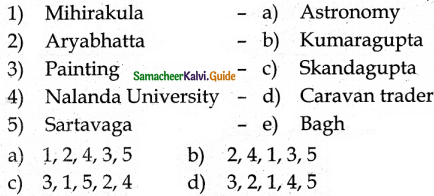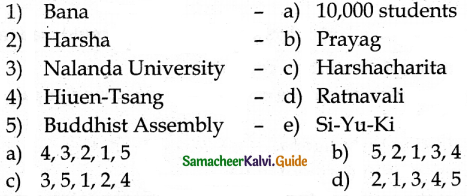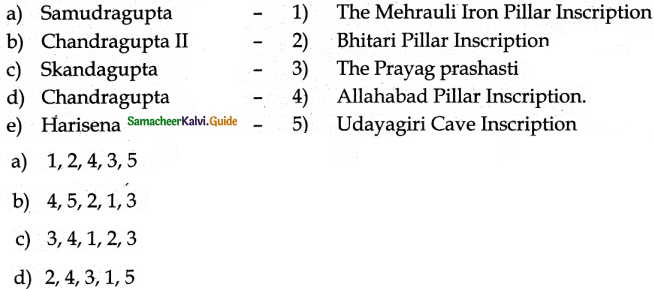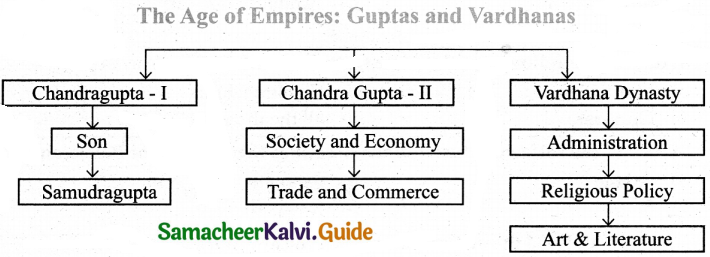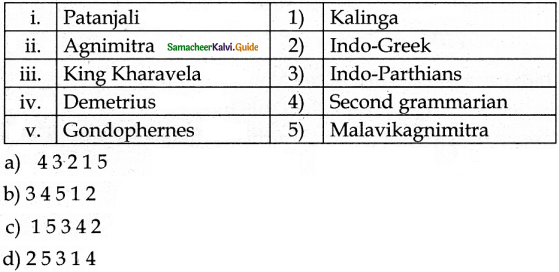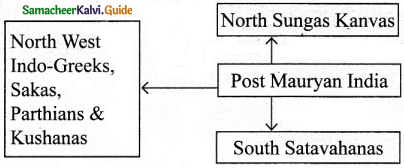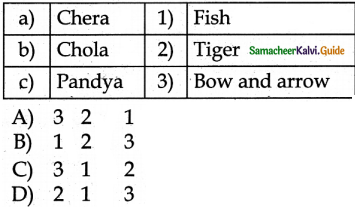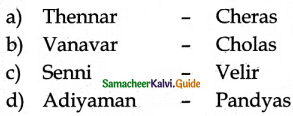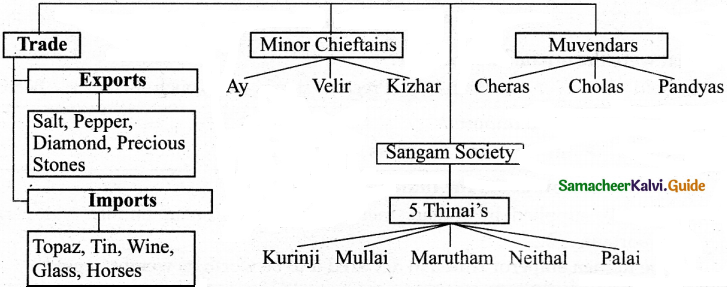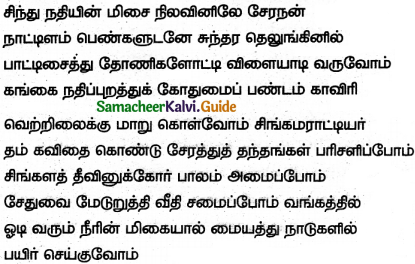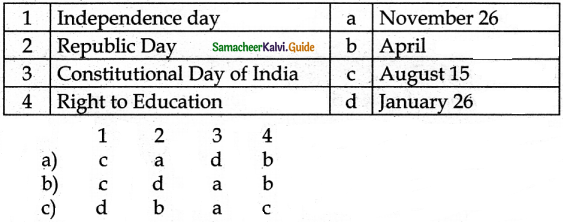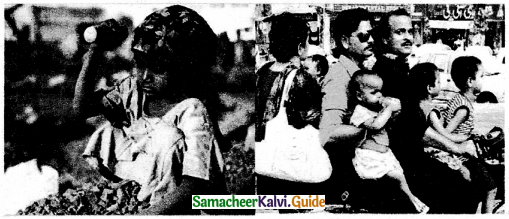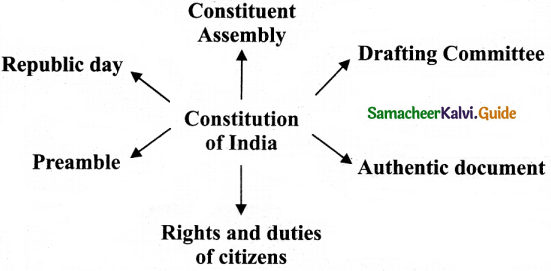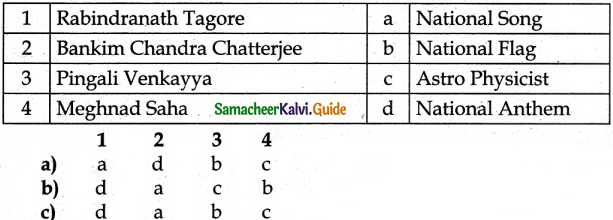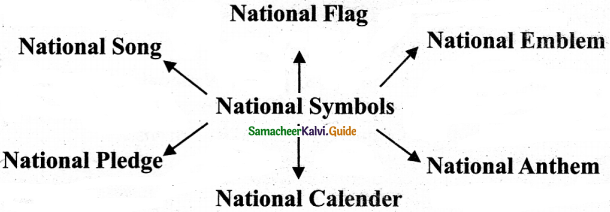Students can Download 6th Tamil Chapter 1.3 வளர்தமிழ் Questions and Answers, Summary, Notes, Samacheer Kalvi 6th Tamil Guide Pdf helps you to revise the complete Tamilnadu State Board New Syllabus, helps students complete homework assignments and to score high marks in board exams.
Tamilnadu Samacheer Kalvi 6th Tamil Solutions Chapter 1.3 வளர்தமிழ்
கற்பவை கற்றபின்
![]()
Question 1.
மாற்றங்களுக்கு ஏற்பத் தன்னைப் புதுப்பித்துக்கொள்ளும் மொழி தமிழ் என்பது பற்றிக் கலந்துரையாடுக.
Answer:
மாணவர்களைக் கால மாற்றத்திற்கேற்ப தன்னைப் புதுப்பித்துக்கொள்ளும் மொழி தமிழ்மொழி பற்றிப் பேசச் செய்தல்.
மாணவன் 1 : வணக்கம். நம் தமிழ்மொழியானது காலத்திற்கேற்றார்போல் தன்னைப் புதுப்பித்துக் கொள்ளும் என்பதில் எவ்வித ஐயமுமில்லை . ‘வடவேங்கடம் தென்குமரி ஆயிடைத் தமிழ் கூறு நல்லுலகம்’ எனப் புகழப்படும் தமிழ் உலகில் பல இலக்கியங்கள் தோன்றிக் கொண்டே தான் உள்ளன. தமிழ் மொழியில் உள்ள இலக்கிய இலக்கண வளங்களால்தான் அழியா நிலை பெற்றுள்ளது எனலாம்.
மாணவன் 2 : அதுமட்டுமா? ஒலியாகத் திரிந்து சித்திரமாய் மாறி பல மொழிகளுடன் இணைந்து உருக்கள் பலப்பல எடுத்தும் காலம் பல கடந்து கல்வெட்டுகளில் செதுக்கப்பட்டும் ஓலைச்சுவடிகளில் வரையப்பட்டும் தற்போது காகிதங்களில் மிளிர்ந்து கொண்டும் உள்ளது நம்தாய் மொழியாம் தமிழ். இது காலச்சூழல் மாற்றங்களுக்கேற்ப தன்னைப் புதுப்பித்துக் கொள்ளும் சிறப்பு பெற்றது.
மாணவன் 1 : பிறமொழிகள் தங்கள் தொன்மை மாறாமலும் அவை இருந்த இடத்திலிருந்து இறங்கி வராமலும் காலத்திற்கேற்ப மாற்றம் கொள்ளாமலும் இருந்ததால் வழக்கொழிந்துவிட்டன. ஆனால் நம் தமிழானது கற்றவர் கல்லாதவர் என அனைவருடைய நாவிலும் நடனமாடுகிறது. இதனால் அழியாப் புகழுடன் விளங்குகிறது. கன்னித்தமிழாய் இருப்பதோடல்லாமல் மொழிகளுக்கெல்லாம் தாயாகவும் விளங்குகிறது.
மாணவன் 2 : சரியாகச் சொன்னாய். தமிழ் மேடைத் தமிழ், எழுத்துத் தமிழ், பேச்சுத் தமிழ் என்று வெவ்வேறு உருவத்தில் தன்னை வளைத்துக் கொடுக்கும் தன்மையால்தான் இன்றும் வளர்ந்து கொண்டே வருகிறது.
மாணவன் 1 : இன்றைய நடைமுறைக்கு ஏற்ப ஊடகங்களில் பயன்படுத்தப்படுகிறது. தமிழ்மொழியானது தனியாக வளர்க்கப்படவில்லை. பக்தி இலக்கியக் காலத்தில் பக்திப் பாடல்கள், சுதந்திரப் போராட்டக் காலத்தில் தேசப்பக்திப் பாடல்கள் என மக்கள் மனதில் வளர்ந்து செழுமை பெற்றுள்ளது.
மாணவன் 2 : சரியாகச் சொன்னாய். இவ்வாறு வளரும் தமிழ்மொழியானது இன்றைய அறிவியல் தொழில்நுட்ப வளர்ச்சியுடன் இணைந்து செல்லும் வகையில் புதிய கலைச் சொற்களை உருவாக்கிக் கொண்டு தமிழ்மொழி தன்னை நாள்தோறும் புதுப்பித்துக் கொண்டே வருகிறது. தமிழ் இணையம், முகநூல், புலனம், குரல் தேடல், தேடுபொறி, செயலி, தொடுதிரை முதலிய சொற்களை உருவாக்குகிறது.
மாண்வன் 1 : அதுமட்டுமா? சமூக ஊடங்களிலும் பயன்படத்தக்க திறன் கொண்ட புது மொழியாகவும் தமிழ் திகழ்ந்து வருகிறது எனலாம். தமிழ் மூத்த மொழியாக மட்டுமின்றி இனிமை, எளிமை, சீர்மை, வளமை, இளமை மிக்க வளர்மொழியாகவும் நாளும் சிறந்து விளங்கும் புதுமொழியாகவும் திகழ்கிறது. தற்போது தமிழ்மொழி அறிவியல் தமிழ், கணினித் தமிழ், மாற்றங்களுக்கு ஏற்றவாறு மேலும் தன்னைப் புதுப்பித்துக் கொள்கிறது. காலத்தின் தேவைக்கேற்ப சரியான சொற்கள் தமிழில் புகுந்து தொடர்ந்து இன்றும் இயங்கி வருகின்றது.
Question 2.
தமிழ் பேசத்தெரியாத குடும்பத்தினர் உங்கள் பக்கத்து வீட்டில் உள்ளனர் அவர்களுக்கு நீங்கள் கற்றுத் தர விரும்பும் பத்துத் தமிழ்ச் சொற்களைப் பட்டியலிடுக.
Answer:
மாணவர்கள் நம் அன்றாட வாழ்வில் பயன்படுத்தும் தமிழ்ச் சொற்களைக் கற்றுத் தருதல்.
தமிழ்சொற்கள் :
1. வணக்கம்
2. வாருங்கள்
3. அமருங்கள்
4. சாப்பிடுங்கள்
5. எப்படி இருக்கிறீர்கள்?
6. உங்கள் பெயர் என்ன?
7. தண்ணீ ர்
8. நன்றி
9. பொறுத்துக்கொள்ளுங்கள்
10. வாழ்க வளர்க
![]()
Question 3.
வாழ்த்துகளைத் தமிழில் கூறுவோம்.
Answer:
மாணவர்கள் தமிழில் வாழ்த்துகளை அறிந்து வந்து எழுதச் செய்தல்.
திருமண வாழ்த்து
பதினாறுப் பெற்று பெறு வாழ்வு வாழ்க!
இரட்டைக்கிளவிபோல் என்றும் சேர்ந்தே வாழ வேண்டும்.
இன்றுபோல் என்றும் இன்முகத்துடன் வாழ்க!
அன்பு, அறிவு, பண்பு, பணிவுடன் வாழ்க பல்லாண்டு!
என்றெல்லாம் அறத்துடன் வாழ வேண்டும்.
எட்டுத்திசைக்கும் புகழ் பரவ வாழ வேண்டும்.
எடுத்துக்காட்டாய் வாழ வேண்டும் என வாழ்த்துகிறோம்.
என் மனமார்ந்த திருமண நல்வாழ்த்துகள்!
என் அன்பான திருமண நல்வாழ்த்துகள்!
மதிப்பீடு
சரியான விடையைத் தேர்ந்தெடுத்து எழுதுக.
Question 1.
‘தொன்மை’ என்னும் சொல்லின் பொருள் ………………..
அ) புதுமை
ஆ) பழமை
இ) பெருமை
ஈ) சீர்மை
Answer:
(விடை: ஆ) பழமை)
Question 2.
‘இடப்புறம்’ என்னும் சொல்லைப் பிரித்து எழுதக் கிடைப்பது ………………..
அ) இடன் + புறம்
ஆ) இடது + புறம்
இ) இட + புறம்
ஈ) இடப் + புறம்
AnsL
(விடை : ஆ) இடது + புறம்)
Question 3.
‘சீரிளமை’ என்னும் சொல்லைப் பிரித்து எழுதக் கிடைப்பது …………….
அ) சீர் + இளமை
ஆ) சீர்மை + இளமை
இ) சீரி + இளமை
ஈ) சீற் + இளமை
Answer:
(விடை: ஆ) சீர்மை + இளமை) .
Question 4.
சிலம்பு + அதிகாரம் என்பதைச் சேர்த்து எழுதக் கிடைக்கும் சொல் …….
அ) சிலம்பதிகாரம்
ஆ) சிலப்பதிகாரம்
இ) சிலம்புதிகாரம்
ஈ) சில பதிகாரம்
Answer:
(விடை: ஆ) சிலப்பதிகாரம்)
Question 5.
கணினி + தமிழ் என்பதைச் சேர்த்து எழுதக் கிடைக்கும் சொல் ……..
அ) கணினிதமிழ்
ஆ) கணினித்தமிழ்
இ) கணிணிதமிழ்
ஈ) கனினிதமிழ்
Answer:
(விடை: ஆ) கணினித்தமிழ்)
![]()
Question 6.
“தமிழ்மொழி போல் இனிதாவது எங்கும் காணோம்” என்று பாடியவர்………….
அ) கண்ண தாசன்
ஆ) பாரதியார்
இ) பாரதிதாசன்
ஈ) வாணிதாசன்
Answer:
(விடை: ஆ) பாரதியார்)
Question 7.
‘மா’ என்னும் சொல்லின் பொருள் ………..
அ) மாடம்
ஆ) வானம்
இ) விலங்கு
ஈ) அம்மா
Answer:
[விடை: இ) விலங்கு)
கோடிட்ட இடத்தை நிரப்புக
1. நாம் சிந்திக்கவும் சிந்தித்ததை வெளிப்படுத்தவும் உதவுவது …………… [விடை : மொழி]
2. தமிழில் நமக்குக் கிடைத்துள்ள மிகப் பழைமையான இலக்கண நூல் …………… [விடை : தொல்காப்பியம்]
3. மொழியைக் கணினியில் பயன்படுத்த வேண்டும் எனில் அது ………. அடிப்படையில் வடிவமைக்கப்பட வேண்டும். [விடை: எண்களின்]
சொற்களைத் சொந்தத் தொடரில் அமைத்து எழுதுக
1. தனிச்சிறப்பு ………………………………..
விடை : திருக்குறள் பல மொழிகளில் மொழிபெயர்ப்பு செய்யப்பட்டுள்ளது அதனின் தனிச்சிறப்பு ஆகும்.
2. நாள்தோறும் …………………………….
விடை : நாம் நாள்தோறும் நல்ல பழக்கவழக்கத்தைக் கடைபிடிப்பது நல்லது.
குறுவினா
Question 1.
தமிழ் மூத்தமொழி எனப்படுவது எதனால்?
Answer:
தமிழ்மொழி – மூத்தமொழி :
(i) இலக்கியங்கள் தோன்றிய பிறகே அவற்றிற்கு இலக்கணம் தோன்றியிருக்க வேண்டும். தமிழில் நமக்குக் கிடைத்துள்ள மிகப் பழமையான இலக்கணநூல் தொல்காப்பியம்.
(ii) இந்நூல் சில ஆயிரம் ஆண்டுகளுக்கு முற்பட்டதாக அறியப்படுகிறது. அதற்கும் முன்னதாகவே தமிழில் இலக்கியங்கள் பல இருந்திருக்க வேண்டும். இதனைக்
கொண்டு தமிழ் தொன்மைமிக்க மூத்த மொழி என்பதை அறியலாம்.
Question 2.
நீங்கள் அறிந்த தமிழ்க் காப்பியங்களின் பெயர்களை எழுதுக.
Answer:
சிலப்பதிகாரம், மணிமேகலை, சீவக சிந்தாமணி, குண்டலகேசி, வளையாபதி, யசோதர காப்பியம், சூளாமணி, நாககுமார காவியம், உதயகுமார காவியம், நீலகேசி.
சிறுவினா
Question 1.
அஃறிணை, பாகற்காய் என்னும் சொற்களின் பொருள் சிறப்பு யாது?
Answer:
அஃறிணை, பாகற்காய் என்னும் சொற்களின் பொருள் சிறப்பு :
(i) திணை – உயர்திணை, அஃறிணை என இருவகைப்படும்.
(ii) உயர்திணையின் எதிர்ச்சொல் தாழ்திணை என அமையவேண்டும்.
(iii) ஆனால் நம் முன்னோர் தாழ்திணை என்று கூறாமல் உயர்வு அல்லாத திணை (அல் + திணை) அஃறிணை என்று பெயரிட்டனர்.
பாகற்காய் :
பாகற்காய் கசப்புச் சுவை உடையது. அதனைக் கசப்புக்காய் என்று கூறாமல், இனிப்பு அல்லாத காய் (பாகு + அல் + காய்) பாகற்காய் என வழங்கினர்.
Question 2.
தமிழ் இனிய மொழி என்பதற்கான காரணம் தருக.
Answer:
தமிழ் இனிய மொழி என்பதற்கான காரணம்:
(i) ஓசை இனிமை, சொல் இனிமை, பொருள் இனிமை ஆகியவை ஒருங்கே அமைந்த இலக்கியங்கள் பலவற்றைக் கொண்டது தமிழ்மொழி.
(ii) பன்மொழி கற்ற கவிஞராகிய பாரதியார், தமிழ் மொழியின் இனிமையை
”யாமறிந்த மொழிகளிலே தமிழ்மொழிபோல்
இனிதாவது எங்கும் காணோம்” என்று பாடுகிறார்.
![]()
Question 3.
தமிழ் மொழியின் சிறப்பைக் குறித்து ஐந்து வரிகளில் எழுதுக.
Answer:
(i) உலக மொழிகள் பலவற்றுள் இலக்கண, இலக்கியவளம் பெற்றுத் திகழும் மொழிகள் மிகச்சிலவே. அவற்றுள் செம்மை மிக்க மொழி என ஏற்றுக் கொள்ளப்பட்டவை ஒரு சில மொழிகளே! தமிழ்மொழி அத்தகு சிறப்பு மிக்க செம்மொழியாகும்.
(ii) தமிழ் இலக்கியங்கள் ஓசை இனிமை, சொல் இனிமை, பொருள் இனிமை கொண்டவை.
(iii) தமிழ் மொழி பேசவும், படிக்கவும், எழுதவும் உகந்த மொழி. தமிழ் எழுத்துகளின் ஒலிப்பு முறை மிக எளிமையானது. தமிழ் எழுத்துகள் பெரும்பாலும் வலஞ்சுழி எழுத்துகளாகவே அமைந்துள்ளன.
(iv) இயல், இசை, நாடகம் என்ற முத்தமிழைக் கொண்ட மொழியாகும். தமிழ் மொழி சொல்வளம் மிக்கது. ஒரு பொருளின் பல நிலைகளுக்கும் வெவ்வேறு பெயர் சூட்டுவது தமிழ்மொழியின் சிறப்பாகும்.
சிந்தனை வினா
Question 1.
தமிழ் மொழி படிக்கவும் எழுதவும் எளியது என்பது பற்றி உங்கள் கருத்து யாது?
Answer:
தமிழ் மொழி படிக்கவும் எழுதவும் எளியமொழி :
(i) தமிழ் எழுத்துகள் வாயைத் திறத்தல், உதடுகளை விரித்தல், குவித்தல் ஆகிய மூன்று எளிய இயக்கங்களால் உயிர் ஒலிகள் பன்னிரண்டையும் எளிமையாக ஒலிக்க . இயலும்.
(ii) நாக்கு, உதடு, பல், அண்ண ம் ஆகிய பேச்சுறுப்புகளின் உதவியால் காற்றை அடைத்தும் வெளியேற்றியும் மெய்யொலிகளை ஒலிக்க இயலும்.
(iii) உயிரும் மெய்யும் இணைவதால் தோன்றுபவை உயிர்மெய் ஒலிகள். உயிர், மெய் ஆகியவற்றின் அடிப்படை ஒலிப்பு முறைகளை அறிந்தால் 216 உயிர்மெய் எழுத்துகளையும் எளிதாகக் கற்கலாம். எழுத்துகளைக் கூட்டி ஒலித்தால் தமிழ் படித்தல் இயல்பாக நிகழும்.
(iv) தமிழ்மொழியை எழுதும் முறையும் மிக எளிமையானது இடப்புறமிருந்து வலப்புறமாகச் சுழித்து எழுதுவது குழந்தைகளின் இயல்பு. இதற்கேற்ப, தமிழ் எழுத்துகள் பெரும்பாலும் வலஞ்சுழி எழுத்துகளாகவே அமைந்துள்ளன. இதன் மூலம் தமிழ்மொழி படிக்கவும் எழுதவும் எளியது என்பதை அறியலாம்.
Question 2.
தமிழ் மொழி வளர்மொழி என்பதை உணர்கிறீர்களா? காரணம் தருக.
Answer:
- தமிழில் காலந்தோறும் பல வகையான இலக்கிய வடிவங்கள் புதிது புதிதாக உருவாகி வருகின்றன.
- துளிப்பா, புதுக்கவிதை, கவிதை, செய்யுள் போன்றன தமிழ்க் கவிதை வடிவங்கள், கட்டுரை, புதினம், சிறுகதை போன்றன உரைநடை வடிவங்கள்.
- தற்போது அறிவியல் தமிழ், கணினித் தமிழ் என்று மேலும் மேலும் வளர்ந்து கொண்டே வருகிறது. எனவே தமிழ்மொழி வளர்மொழி என்பதை உணர்கிறேன்.
